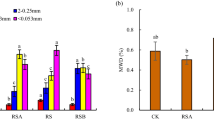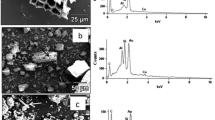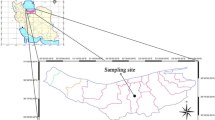Abstract
Recalcitrant charcoal application is predicted to decelerate global warming through creating a long-term carbon sink in soil. Although many studies have showed high stability of charcoal derived from woody materials, few have focused on the dynamics of straw-derived charcoal in natural environment on a long timescale to evaluate its potential for agricultural carbon sequestration. Here, we examined straw-derived charcoal in an ancient paddy soil dated from ~3700 calendar year before present (cal. year bp). Analytical results showed that soil organic matter consisted of more than 25 % of charcoal in charcoal-rich layer. Similarities in morphology and molecular structure between the ancient and the fresh rice-straw-derived charcoal indicated that ancient charcoal was derived from rice straw. The lower carbon content, higher oxygen content, and obvious carbonyl of the ancient charcoal compared with fresh rice straw charcoal implied that oxidation occurred in the scale of thousands years. However, the dominant aromatic C of ancient charcoal indicated that rice-straw-derived charcoal was highly stable in the buried paddy soil due to its intrinsic chemical structures and the physical protection of ancient paddy wetland. Therefore, it may suggest that straw charcoal application is a potential pathway for C sequestration considering its longevity.





Similar content being viewed by others
References
Agbagla-Dohnani A, Nozière P, Clément G, Doreau M (2001) In sacco degradability, chemical and morphological composition of 15 varieties of European rice straw. Anim Feed Sci Technol 94:15–27
Ascough P, Bird M, Francis S, Thornton B, Midwood A, Scott A, Apperley D (2011) Variability in oxidative degradation of charcoal: influence of production conditions and environmental exposure. Geochim Cosmochim Acta 75:2361–2378
Baldock JA, Skjemstad J (2000) Role of the soil matrix and minerals in protecting natural organic materials against biological attack. Org Geochem 31:697–710
Bird M, Moyo C, Veenendaal E, Lloyd J, Frost P (1999) Stability of elemental carbon in a savanna soil. Glob Biogeochem Cycle 13:923–932
Brewer CE, Schmidt-Rohr K, Satrio JA, Brown RC (2009) Characterization of biochar from fast pyrolysis and gasification systems. Environ Prog Sustain Energy 28:386–396
Cao Z, Ding J, Hu Z, Knicker H, Kögel-Knabner I, Yang L, Yin R, Lin X, Dong Y (2006) Ancient paddy soils from the Neolithic age in China’s Yangtze River Delta. Naturwissenschaften 93:232–236
Chia CH, Munroe P, Joseph S, Lin Y (2010) Microscopic characterisation of synthetic Terra Preta. Soil Res 48:593–605
Cusack DF, Chadwick OA, Hockaday WC, Vitousek PM (2012) Mineralogical controls on soil black carbon preservation. Glob Biogeochem Cycle 26:GB2019. doi:10.1029/2011GB004109
Czimczik CI, Masiello CA (2007) Controls on black carbon storage in soils. Glob Biogeochem Cycle 21:GB3005. doi:10.1029/2006GB002798
Ding P, Zheng Y, Chen X, Zhong S, Wang N (2010) The archaeological site of Maoshan lying in Linping. China Cultural Relics News, Yuhang District (in Chinese)
Dong D, Yang M, Wang C, Wang H, Li Y, Luo J, Wu W (2013) Responses of methane emissions and rice yield to applications of biochar and straw in a paddy field. J Soils Sediments 13:1450–1460
Downie AE, Van Zwieten L, Smernik RJ, Morris S, Munroe PR (2011) Terra Preta Australis: reassessing the carbon storage capacity of temperate soils. Agr Ecosyst Environ 140:137–147
FAO (2013) Rice & climate change. http://www.fao.org/fileadmin/templates/agphome/documents/Rice/rice_fact_sheet.pdf.
Forbes M, Raison R, Skjemstad J (2006) Formation, transformation and transport of black carbon (charcoal) in terrestrial and aquatic ecosystems. Sci Total Environ 370:190–206
Glaser B, Amelung W (2003) Pyrogenic carbon in native grassland soils along a climosequence in North America. Glob Biogeochem Cycle 17(2):1064. doi:10.1029/2002GB002019
Glaser B, Birk JJ (2012) State of the scientific knowledge on properties and genesis of Anthropogenic Dark Earths in Central Amazonia (terra preta de Índio). Geochim Cosmochim Acta 82:39–51
Glaser B, Haumaier L, Guggenberger G, Zech W (2001) The ‘Terra Preta’ phenomenon: a model for sustainable agriculture in the humid tropics. Naturwissenschaften 88:37–41
Gu F, Wang W, Jing L, Jin Y (2013) Sulfite–formaldehyde pretreatment on rice straw for the improvement of enzymatic saccharification. Bioresour Technol 142:218–224
Guerrero M, Ruiz MP, Millera Á, Alzueta MU, Bilbao R (2008) Characterization of biomass chars formed under different devolatilization conditions: differences between rice husk and eucalyptus. Energy Fuels 22:1275–1284
Hammes K, Smernik RJ, Skjemstad JO, Herzog A, Vogt UF, Schmidt MW (2006) Synthesis and characterisation of laboratory-charred grass straw (Oryza sativa) and chestnut wood (Castanea sativa) as reference materials for black carbon quantification. Org Geochem 37:1629–1633
Hammes K, Torn MS, Lapenas AG, Schmidt MW (2008) Centennial black carbon turnover observed in a Russian steppe soil. Biogeosciences 5:1339–1350
Hua L, Wu W, Liu Y, McBride MB, Chen Y (2009) Reduction of nitrogen loss and Cu and Zn mobility during sludge composting with bamboo charcoal amendment. Environ Sci Pollut Res 16:1–9
Karlen DL, Lal R, Follett RF, Kimble JM, Hatfield JL, Miranowski JM, Cambardella CA, Manale A, Anex RP, Rice CW (2009) Crop residues: the rest of the story. Environ Sci Technol 43:8011–8015
Keiluweit M, Nico PS, Johnson MG, Kleber M (2010) Dynamic molecular structure of plant biomass-derived black carbon (biochar). Environ Sci Technol 44:1247–1253
Kleber M, Nico PS, Plante A, Filley T, Kramer M, Swanston C, Sollins P (2011) Old and stable soil organic matter is not necessarily chemically recalcitrant: implications for modeling concepts and temperature sensitivity. Glob Change Biol 17:1097–1107
Knoblauch C, Maarifat A-A, Pfeiffer E-M, Haefele SM (2011) Degradability of black carbon and its impact on trace gas fluxes and carbon turnover in paddy soils. Soil Biol Biochem 43(9):1768–1778
Lehmann J (2003) Amazonian dark earths: origin, properties, management. Springer-Verlag New York Inc
Leifeld J, Fenner S, Müller M (2007) Mobility of black carbon in drained peatland soils. Biogeosciences 4:425–432
Liang B, Lehmann J, Solomon D, Kinyangi J, Grossman J, O’neill B, Skjemstad J, Thies J, Luizao F, Petersen J (2006) Black carbon increases cation exchange capacity in soils. Soil Sci Soc Am J 70:1719–1730
Liang B, Lehmann J, Solomon D, Sohi S, Thies JE, Skjemstad JO, Luizao FJ, Engelhard MH, Neves EG, Wirick S (2008) Stability of biomass-derived black carbon in soils. Geochim Cosmochim Acta 72:6069–6078
Liang B, Lehmann J, Sohi SP, Thies JE, O’Neill B, Trujillo L, Gaunt J, Solomon D, Grossman J, Neves EG (2010) Black carbon affects the cycling of non-black carbon in soil. Org Geochem 41:206–213
Lim B, Cachier H (1996) Determination of black carbon by chemical oxidation and thermal treatment in recent marine and lake sediments and Cretaceous-Tertiary clays. Chem Geol 131:143–154
Liu Y, Yang M, Wu Y, Wang H, Chen Y, Wu W (2011) Reducing CH4 and CO2 emissions from waterlogged paddy soil with biochar. J Soils Sediments 11:930–939
Llorente M, Glaser B, Turrión MB (2010) Storage of organic carbon and Black carbon in density fractions of calcareous soils under different land uses. Geoderma 159:31–38
Luo Y, Durenkamp M, De Nobili M, Lin Q, Brookes P (2011) Short term soil priming effects and the mineralisation of biochar following its incorporation to soils of different pH. Soil Biol Biochem 43:2304–2314
Major J, Lehmann J, Rondon M, Goodale C (2010) Fate of soil-applied black carbon: downward migration, leaching and soil respiration. Glob Change Biol 16:1366–1379
Mao J-D, Johnson R, Lehmann J, Olk D, Neves E, Thompson M, Schmidt-Rohr K (2012) Abundant and stable char residues in soils: implications for soil fertility and carbon sequestration. Environ Sci Technol 46:9571–9576
McBeath AV, Smernik RJ (2009) Variation in the degree of aromatic condensation of chars. Org Geochem 40:1161–1168
Mohanty P, Nanda S, Pant KK, Naik S, Kozinski JA, Dalai AK (2013) Evaluation of the physiochemical development of biochars obtained from pyrolysis of wheat straw, timothy grass and pinewood: effects of heating rate. J Anal Appl Pyrolysis 104:485–493
Nguyen BT, Lehmann J (2009) Black carbon decomposition under varying water regimes. Org Geochem 40:846–853
Nguyen BT, Lehmann J, Hockaday WC, Joseph S, Masiello CA (2010) Temperature sensitivity of black carbon decomposition and oxidation. Environ Sci Technol 44:3324–3331
Ohlson M, Dahlberg B, Økland T, Brown KJ, Halvorsen R (2009) The charcoal carbon pool in boreal forest soils. Nat Geosci 2:692–695
Pan G, Li L, Wu L, Zhang X (2004) Storage and sequestration potential of topsoil organic carbon in China’s paddy soils. Glob Change Biol 10:79–92
Reimer PJ, Baillie MG, Bard E, Bayliss A, Beck JW, Bertrand EJH, Blackwell PG, Buck EE, Burr GS, Cutler KB, Damon PE, Edwards RL, Fairbanks RG, Friedrich M, Guilderson TP, Hogg AG, Hughen KA, Kromer B, McCormac FG, Manning S, Bronk Ramsey E, Reimer RW, Remmele S, Southon JR, Stuiver M, Talamo S, Taylor FW, van der Plicht J, Weyhenmeyer EE (2004) INTCAL04 terrestrial radiocarbon age calibration, 0-26 cal kyr BP. Radiocarbon 46:1029–1058
Schmidt MW, Skjemstad JO, Jäger C (2002) Carbon isotope geochemistry and nanomorphology of soil black carbon: Black Chernozemic soils in central Europe originate from ancient biomass burning. Glob Biogeochem Cycle 16:70-1-70-8
Schmidt MW, Torn MS, Abiven S, Dittmar T, Guggenberger G, Janssens IA, Kleber M, Kögel-Knabner I, Lehmann J, Manning DA (2011) Persistence of soil organic matter as an ecosystem property. Nature 478:49–56
Singh BP, Cowie AL, Smernik RJ (2012a) Biochar carbon stability in a clayey soil as a function of feedstock and pyrolysis temperature. Environ Sci Technol 46:11770–11778
Singh N, Abiven S, Torn M, Schmidt M (2012b) Fire-derived organic carbon in soil turns over on a centennial scale. Biogeosciences 9:2847–2857
Wu W, Yang M, Feng Q, McGrouther K, Wang H, Lu H, Chen Y (2012) Chemical characterization of rice straw-derived biochar for soil amendment. Biomass Bioenergy 47:268–276
Zheng Y (2010) The new advance of the archaeology of the rice cultivation in the lower reach of the Yangtzi River. China Economic History http://economy.guoxue.com/?p=1294. (in Chinese)
Zimmerman AR (2010) Abiotic and microbial oxidation of laboratory-produced black carbon (biochar). Environ Sci Technol 44:1295–1301
Zimmerman AR, Gao B, Ahn M-Y (2011) Positive and negative carbon mineralization priming effects among a variety of biochar-amended soils. Soil Biol Biochem 43:1169–1179
Zimmermann M, Bird MI, Wurster C, Saiz G, Goodrick I, Barta J, Capek P, Santruckova H, Smernik R (2012) Rapid degradation of pyrogenic carbon. Glob Change Biol 18:3306–3316
Acknowledgments
This research was supported by the National Natural Science Foundation of China (41271247), the Specialized Research Fund for the Doctoral Program of Higher Education (20110101110083), and the Natural Science Foundation of Zhejiang Province (R5100044). The NMR analysis was performed in the Solid-State Nuclear Magnetic Resonance Laboratory, Nanjing University. We sincerely thank Xiaokang Ke at Nanjing University for assistance on NMR analysis and Dr. Saran Paul Sohi for providing helpful comments on the manuscript.
Conflict of interest
The authors declare that they have no conflict of interest.
Research involving human participants and/or animals
This article does not contain any studies with human participants or animals performed by any of the authors.
Informed consent
Informed consent was obtained from all individual participants included in the study.
Author information
Authors and Affiliations
Corresponding author
Additional information
Responsible editor: Zhihong Xu
Electronic supplementary material
Below is the link to the electronic supplementary material.
ESM 1
(DOC 421 kb)
Rights and permissions
About this article
Cite this article
Wu, M., Yang, M., Han, X. et al. Highly stable rice-straw-derived charcoal in 3700-year-old ancient paddy soil: evidence for an effective pathway toward carbon sequestration. Environ Sci Pollut Res 23, 1007–1014 (2016). https://doi.org/10.1007/s11356-015-4422-x
Received:
Accepted:
Published:
Issue Date:
DOI: https://doi.org/10.1007/s11356-015-4422-x




